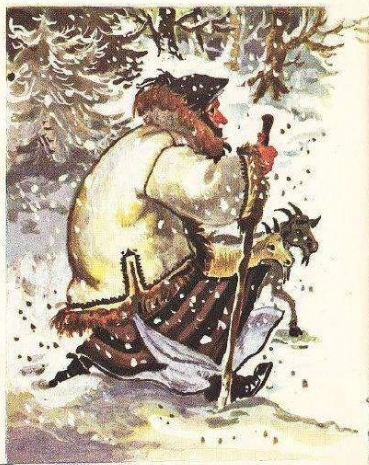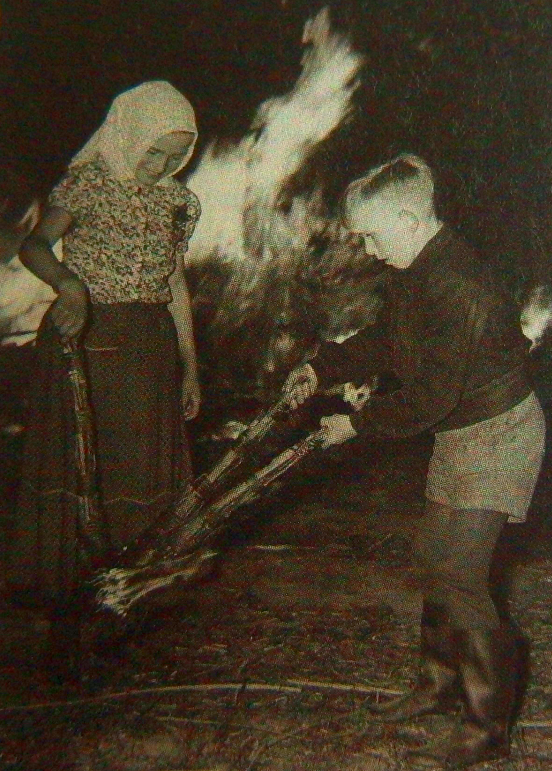Illustration by Bernard Zuber for Maurice Garçon’s La Vie Execrable de Guillemette Babin, Sorciere, 1926.
May Day Eve (April 30) is across Northern and Central Europe known as Walpurgis Night, the night when everyone is trying to "ward off, scare, witches"...
Why?
Maybe this has something to do with the old Celtic calendar which divided the year into two halves:
Winter (Samhain, 1st of Nov - Beltane, 1st of May)
Summer (Beltane, 1st of May - Samhain, 1st of Nov)
I talked about this in my post "Two crosses"...
This division of the year, is btw based on the old transhumance shepherd calendar:
Lowland grazing and lambing Oct/Nov - Apr/May
Highland grazing and milking Apr/May - Oct/Nov
I talked about this in my post "April"...
In Serbian Orthodox calendar, the beginning and the end of the "Time of Dragons", the hot sunny half of the year, is marked (guarded) by Two Georges, Summer and Winter St George('s day)...I talked about this in my post "Two Georges"...
This is important to know as a lot of old traditions linked to Beltane were migrated to the Summer St George day...
Where do witches come into the picture here?
Remember this: Hey, you Halloween witches, dressing up in black on the first day of winter...You know that The Witch here is The Hag, Winter Earth, Baba, Cailleach, The Dark, Veiled One...Here she is, all in black, with bare branch, on the four seasons Roman mosaic from the Bignor
The witch here is the Old (Winter) Mother Earth.
In the Polish Carpathians we find this saying:
"Baba (Grandmother) is already frozen" meaning "The mountain tops are covered with frost or the first snow".
I talked about this in my post "Gryla" about Winter Hag, Winter Earth...
Baba Dochia was an old woman who insulted the month of March. So, while she was going up the mountain with a herd of goats (symbols of winter), March borrowed frosty days from February and froze her to death...
I talked about this legend from Romania in my post "Baba, cold, winter"...
Slovenian folk play called "Baba (grandmother) and Ded (grandfather)": "As they get older he gets weaker and she gets stronger. At one point she takes over him and rules until spring".
This makes a lot of sense if Baba (Earth, Yin, Cold) and Ded (Sun, Yang, Heat)...
Ever changing Yin-Yang symbol is most likely description of the ever changing daily amount of light and darkness and the effect this change has on Earth's temperature...
More about it in my post "Yin and Yang"...
The winter earth is actually depicted as a witch in the Snow White.
Crab apples are the last fruit to stay on the branches in Continental Europe, well into winter.
Winter, which was imagined by our ancestors as "an old hag, and old witch" veiled in black, the bringer of death...
The one Slavs called Morana (the goddess of death) and Marzana (the goddess of cold). From my post "Snow-White"...
Some Slavs performed burning of the witch of winter/goddess of death at the beginning of spring (Jan/Feb)...
"Maslenitsa" by Simon Kozhin.
As I said, Slavs equated The Goddess of Death, Morana (mor=death) with The Winter Earth, Marzana (marz=frost). She is ceremonially burned (warmed) or drowned (thawed) or both (to de sure to be sure 🙂) during Slavic spring festivals...
Here are some posts in which I talk about this ritual and related customs: "Gryla", "Party" "Bannock", "To kill a witch", "Baba's day", "Living stone"...
Like Sorbs (Slavs) from Germany, who at the end of April perform "Chodojtypalenje" (the witch burning). A large stack of branches is piled and a straw witch effigy is placed on top. The whole thing is then set ablaze symbolically "killing winter" (witch=hag=winter)
As I said above, in Serbian and Celtic calendar, year had two seasons: winter Samhain (start of November) to Bealtaine (start of May), and summer Bealtaine to Samhain. Hence Sorbian witch burning at the end of April, just before the start of summer...
Here is a picture of one of these "witches" (hags) being burned.
Christianised version of this custom is Walpurgis Night. "As a result of Saint Walpurga's evangelism in Germany, the people there converted to Christianity from heathenism. Saint Walpurga was also known to repel the effects of witchcraft..." 😉
I think that by now you can all see that what was burned on these bonfires was not a witch but the Hag, Ugly, Evil, Winter earth, The Goddess of Death. Who is transformed, every spring, by the fire of the sun into Beautiful, Good, Summer Earth, The Goddess of Life...This "burning" is not destruction but transformation by fire...
The fire lit at these ceremonies is supposed to ignite the reproductive fire of the mother earth. We don't want frigid winter hag, we want hot spring maiden 🙂 burning with desire for her young sun lover. Without this fire there is no life...
In the Balkans they also performed the scaring of the witch of winter
As part of end of winter, beginning of summer rituals, men and boys in Bosnia blew willow horns to scare the witch (winter) away...As I said, the old Serbian year, just like the old Celtic year, was divided into summer (Apr/May-Oct/Nov) and winter (Oct/Nov-Apr/May)...
I talked about this in my post "May horns"...
This link between Mother earth and Yin, dark, wet, cold weather, resulted in the women being the ones who in Slavic tradition performed Yin, dark, wet, cold magic.
I talked about this in two posts, "Weather stones", about the use of "weather stones" among Slavs and "The last megalithic ritual in Europe", which talks about a ritual from Belarus, where women (Yin, dark, wet, cold) raise Dabog's (sun and rain god) stone during drought to get cool and wet weather...
And in the post "Thunder book" where we read about the prosecution of female witches in medieval Serbia for performing weather magic...
The association between (Yin, dark, wet, cold) magic and women seems to have been common in the past in the rest of Europe too.
Two witches conjuring a hailstorm, an illustration from the 1489 book "De Lamiis et Pythonicis Mulieribus" by Ulrich Molitor which talks about weather altering magic (witchcraft) performed by women...
Did you know that the sudden climate change which resulted in the medieval mini ice age was blamed on the weather controlling witches and was the excuse for the subsequent witch-hunt? I talked about this in my post "De Lamiis et Pythonicis Mulieribus"...
Now that we know who witches were, I think it is interesting that witches seem to have liked riding on two things which are both associated with storms and winter: brooms and goats...
Broom...Remeber my post "Donderbezem" about Donderbezem (thunder broom), a protective symbol used in Holland and northern Germany as a protection from lightning strikes and evil spirits.
Goat...Goat is universally associated with dark, cold, wet half of the year (Oct/Nov - Apr/May) in Europe, Eastern Mediterranean, Western Asia, Mesopotamia, Central Asia, Iran...This is because ibex goat mating season starts in Oct/Nov and the ibex goat birthing season finishes in Apr/May...
I talked about symbolism of ibex goats in many of my posts, like
Europe:
"Pitys", "Goat in European culture", "Patera of Rennes", "Gotland sun stone with horses and ibexes"...
Levant:
"The tree of life/light", "Lachish animal calendar"...
Mesopotamia:
"Feast plaque from Louvre", "Green pastures", "Problems with Abzu", "Relief from Dur Sharrukin", "Goatfish"...
Iran:
"Flamingos from Susa", "Goat carrier", "Iranian goat of rain", "Strider", "A vessel from Tepe Hissar", "Rhubarb and ibex"...
Interesting, right?
Anyway, don't just sit there. Go burn a witch. We all had enough of winter...




















No comments:
Post a Comment